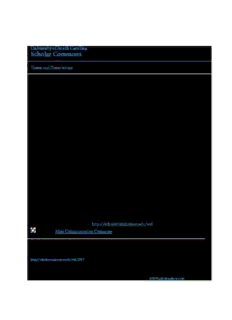
Toward A Situational Technology Acceptance Model: Combining the Situational Theory of Problem PDF
Preview Toward A Situational Technology Acceptance Model: Combining the Situational Theory of Problem
UUnniivveerrssiittyy ooff SSoouutthh CCaarroolliinnaa SScchhoollaarr CCoommmmoonnss Theses and Dissertations 2016 TToowwaarrdd AA SSiittuuaattiioonnaall TTeecchhnnoollooggyy AAcccceeppttaannccee MMooddeell:: CCoommbbiinniinngg tthhee SSiittuuaattiioonnaall TThheeoorryy ooff PPrroobblleemm SSoollvviinngg aanndd TTeecchhnnoollooggyy AAcccceeppttaannccee MMooddeell ttoo PPrroommoottee MMoobbiillee DDoonnaattiioonnss ffoorr NNoonnpprroofifitt OOrrggaanniizzaattiioonnss Yue Zheng University of South Carolina Follow this and additional works at: https://scholarcommons.sc.edu/etd Part of the Mass Communication Commons RReeccoommmmeennddeedd CCiittaattiioonn Zheng, Y.(2016). Toward A Situational Technology Acceptance Model: Combining the Situational Theory of Problem Solving and Technology Acceptance Model to Promote Mobile Donations for Nonprofit Organizations. (Doctoral dissertation). Retrieved from https://scholarcommons.sc.edu/etd/3797 This Open Access Dissertation is brought to you by Scholar Commons. It has been accepted for inclusion in Theses and Dissertations by an authorized administrator of Scholar Commons. For more information, please contact [email protected]. Toward A Situational Technology Acceptance Model: Combining the Situational Theory of Problem Solving and Technology Acceptance Model to Promote Mobile Donations for Nonprofit Organizations by Yue Zheng Bachelor of Arts Renmin University of China, 2008 Master of Science Iowa State University of Science and Technology, 2012 Submitted in Partial Fulfillment of the Requirements For the Degree of Doctor of Philosophy in Mass Communications College of Information and Communications University of South Carolina 2016 Accepted by: Brooke W. McKeever, Major Professor Andrea H. Tanner, Committee Member S. Mo Jang, Committee Member Daniela B. Friedman, Committee Member Lacy Ford, Senior Vice Provost and Dean of Graduate Studies © Copyright by Yue Zheng, 2016 All Rights Reserved. ii DEDICATION To my parents, who consistently support my career in academia. iii ACKNOWLEDGEMENTS A dissertation cannot be finished by entirely one person. I take this opportunity to acknowledge those who have made efforts on my doctoral accomplishment. I would like to express my deep appreciation to my advisor, Dr. Brooke W. McKeever, for her patient and careful guidance all the way from inspiring my interest in nonprofit communication, mentoring my internship and job application, through to completion of this degree. I would also like to thank Dr. Andrea H. Tanner, who incorporated me into her health communication research, cheered me up countless times when I was frustrated, and never doubted that I could achieve this goal; thank Dr. S. Mo Jang, who used his statistics talent to help my data analysis; and thank Dr. Daniela B. Friedman, who embedded the knowledge of public health into my communication study and reviewed my research point to point. I would also like to thank School of Journalism and Mass Communications to fund my research and thank the faculty and staff who have contributed to my growth of research, teaching, and job searching, including Dr. Shannon Bowen, Dr. August Grant, Dr. Ran Wei, Dr. Carol Pardun, Dr. Kathy Forde, Dr. Sei-hill Kim, Dr. Kenneth Campbell, Dr. Robert McKeever, Dr. Erik Collins, Dr. Keith Kenney, Ms. Lisa Sisk, and Ms. Sandra Hughes. Last but not least, I am grateful to my family, cohorts, and friends for their strong support. A special thanks to my roommates, Dr. Wan Chi Leung and Miss Wenjia Wang, who went through this special journey and shared a lot of memorable moments with me. iv ABSTRACT Using a nationwide survey of 994 respondents in February 2016, this study combines the situational theory of problem solving and technology acceptance model to refine the conceptual understandings of people’s motivations to make a mobile donation benefiting health-related nonprofit organizations. Findings provide empirical support for the combined model and an emerging situational technology acceptance model. Mobile phone users’ intentions to make a mobile donation are mostly influenced by their attitudes toward using technology and subjective norms. Practical implications are also discussed for nonprofit practitioners to better segment publics, design strategic messages, and disseminate communication campaigns to improve future fundraising. v TABLE OF CONTENTS DEDICATION………………………………………………………………………….. .iii ACKNOWLEDGEMENTS…………………………………………………………….. .iv ABSTRACT…………………………………………………………………………….. ..v LIST OF TABLES……………………………………………………………………… .ix LIST OF FIGURES…………………………………………………………………….. ..x LIST OF ABBREVIATIONS…………………………………………………………... .xi CHAPTER 1: INTRODUCTION………………………………………………………. ..1 1.1 Text Messaging and Mobile Donation……………………………………… ..1 1.2 Health-Related Nonprofit Organizations…………………………………… ..5 1.3 Situational Theory of Problem Solving (STOPS)…………………………... ..7 1.4 Technology Acceptance Model (TAM)…………………………………….. ..9 1.5 Significance…………………………………………………………………. 10 CHAPTER 2: LITERATURE REVIEW……………………………………………….. 12 2.1 Situational Theory of Publics (STP)…………... ………………………....... 12 2.2 Situational Theory of Problem Solving (STOPS)……………………........... 20 vi 2.3 Situational Theory and Philanthropy, Nonprofits, and Voluntary Sectors…………………………………………………………………………. 28 2.4 Technology Acceptance Model (TAM)……………………………………. 32 2.5 Technology Acceptance Model and Mobile Communications……………. 36 2.6 Proposed Situational Technology Acceptance Model …………………….. 42 CHAPTER 3: METHODS…………………………………………………………….. 45 3.1 Survey Procedure…………………………………………………………... 46 3.2 Survey Measures…………………………………………………………… 49 3.3 Data Collection and Analysis……………………………………………… 54 CHAPTER 4: RESULTS………………………………………………………………. 55 4.1 Demographic Characteristics of Respondents……………………………... 55 4.2 Donors’ Demographics and Mobile Donation Experiences……………….. 56 4.3 Non-donors’ Demographics and Donation Intentions………………….….. 57 4.4 Use and Preference of Media Channels……………………………………. 58 4.5 Hypothesis Testing…………………………………………………………. 59 CHAPTER 5: DISCUSSION………………………………………………………….. 75 5.1 Mobile Donation Market…………………………………………………... 76 5.2 Theoretical and Methodological Contributions……………………………. 79 vii 5.3 Practical Implications……………………………………………………… 85 5.4 Limitations and Future Research…………………………………………... 93 5.5 Conclusions………………………………………………………………… 95 REFERENCES……………………………………………………………………….. ..97 APPENDIX A: SURVEY QUESTIONNAIRE………………………….………….. .109 viii LIST OF TABLES Table 4.1 Demographic Characteristics of Respondents………………………………. 62 Table 4.2 Demographics Characteristics of Donors…………………………………… 63 Table 4.3 Demographic Characteristics of Non-donors……………………………….. 65 Table 4.4 Means, Standard Deviations, Reliabilities, and Standardized Factor Loadings……………………………………………………………………….. 67 Table 4.5 Covariance Matrix among Latent Variables………………………………… 70 Table 4.6 Correlation Matrix among Latent Variables………………………………… 70 Table 4.7 Hypotheses Testing of Situational Technology Acceptance Model…..…...... 72 Table 4.8 Covariance Matrix among Independent Variables………………………….. 73 ix
Description: